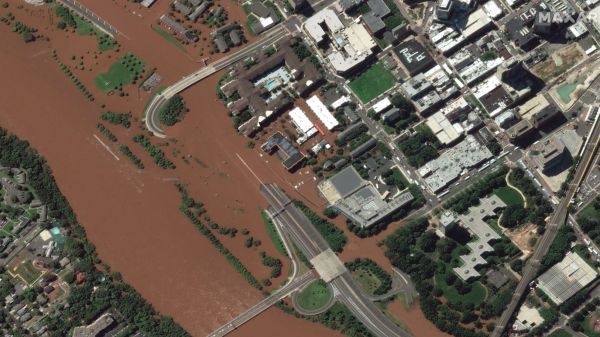When you purchase through links on our web site , we may take in an affiliate commission . Here ’s how it wreak .
Rob Mooreis a older policy analyst for NRDC where he is part of a team devoted to protecting U.S. H2O resources . Moore contributed this clause to Live Science’sExpert Voices : Op - Ed & Insights .
The U.S. Federal Emergency Management Agency ( FEMA ) is tasked with helping pass judgment the nation ’s vulnerability to flooding and storm surges , and providing mathematical function that reflect the best scientific understanding of where flooding is most likely to fall out .

Entrance to Battery Park flooded, NYC DOT truck seen submerged, blocking entrance after early closure on Oct. 29.
FEMA function guide people out of scathe ’s means , helping homeowners make informed choices about where they be ; aiding metropolis as they decide where where to build critical infrastructure , schools and hospital ; and assisting business proprietor as they decide where to correct - up shop .
But FEMA ’s deluge maps have never accounted for thefuture impacts of climate changeon alluvion endangerment .
Hurricane Sandy served as a wake - up call for New York and New Jersey — and the nation — to become intimately prepared for implosion therapy and the other impacts of clime change . As Sandy exemplify with fearsome efficiency , implosion therapy is among the biggest risk the nation face from climate modification — as the climate warms , sea levels uprise while extreme weather and violent storm surges raise the likeliness of floods .

Entrance to Battery Park flooded, NYC DOT truck seen submerged, blocking entrance after early closure on Oct. 29.
give that it can take two decennary or longer for FEMA to update flood tide mapping for an area , it ’s important that those maps startle providing a more realistic aspect at both presentandfuture risk .
In fact , doing so is now required by law . In 2012 , Congress passed legislation that require FEMA to factor in future climate risks , as part of the Biggert - Waters Flood Insurance Reform Act .
kick in the impact of Hurricane Sandy it was trust that young maps for New York City might be the test case for how to account for sea - level advance and climate - related wallop . But when FEMA liberate update maps latterly , these risks were still not accounted for .

If you’re a topical expert — researcher, business leader, author or innovator — and would like to contribute an op-ed piece,email us here.
When Hurricane Sandy flooded parts of New York City many residents never expect to be submerged because photoflood maps did not show their neighbored as being in the danger zona . In the aftermath , it became all too clear how out of date FEMA ’s map of flood zones were , having pull up stakes communities in the wickedness about the risk they actually face , as illustrated in the image below .
Residents of New York will likely find that FEMA ’s newly proposed maps are similarly obsolete in coming age . Assea levels continue to rise , the arena susceptible to flooding will also increase . The New York Department of State , using data point from FEMA ’s new flood maps and storm - modeling information from the National Oceanic and Atmospheric Administration , assembled an interesting set of Risk Assessment Maps that show how flood danger change in reception to ocean level rise . Below is a comparison between those maps and FEMA ’s .
As you may see , the region at risk in the future is far more extensive than FEMA ’s raw maps indicate . New Yorkers may not experience the impacts of this in the short - term , but the last maps were not updated for 30 old age . If New York has to wait another 30 days , FEMA ’s proposed maps earnestly underrate the risk of flooding for the city .

Areas flooded by Sandy (red) far exceeded the flood plain delineated on FEMA’s flood maps. These maps had been digitized in 2007, but the underlying data had not been updated since 1983.
New York is not alone . All across the land , river- and coastal - flood maps are woefully out of date . New Yorkers acknowledge firsthand the importance of making indisputable FEMA ’s update maps reflect real implosion therapy risks . We are number on the government agency to revisit their update maps and give New Yorkers — and ultimately the entire land — a material judgment of what ’s at stakes , and how to well cook for the future .
Moore ’s most recent Op - Ed was " After Sandy , Lessons from Historic 1993 Flood Resurface " . The views state are those of the author and do not needfully excogitate the views of the publisher . This version of the article was in the first place published onLive scientific discipline .

This image overlays the 100-year floodplain mapped by FEMA with information the New York Department of State. The red corresponds to areas at the highest risk of flooding, the blue indicates the 100-year flood plain (as delineated on FEMA’s new maps), and the cream colored area shows areas vulnerable to flooding when considering 3 feet of sea-level rise or the surge from a category 3 hurricane (Sandy was barely a category 1 storm).

















